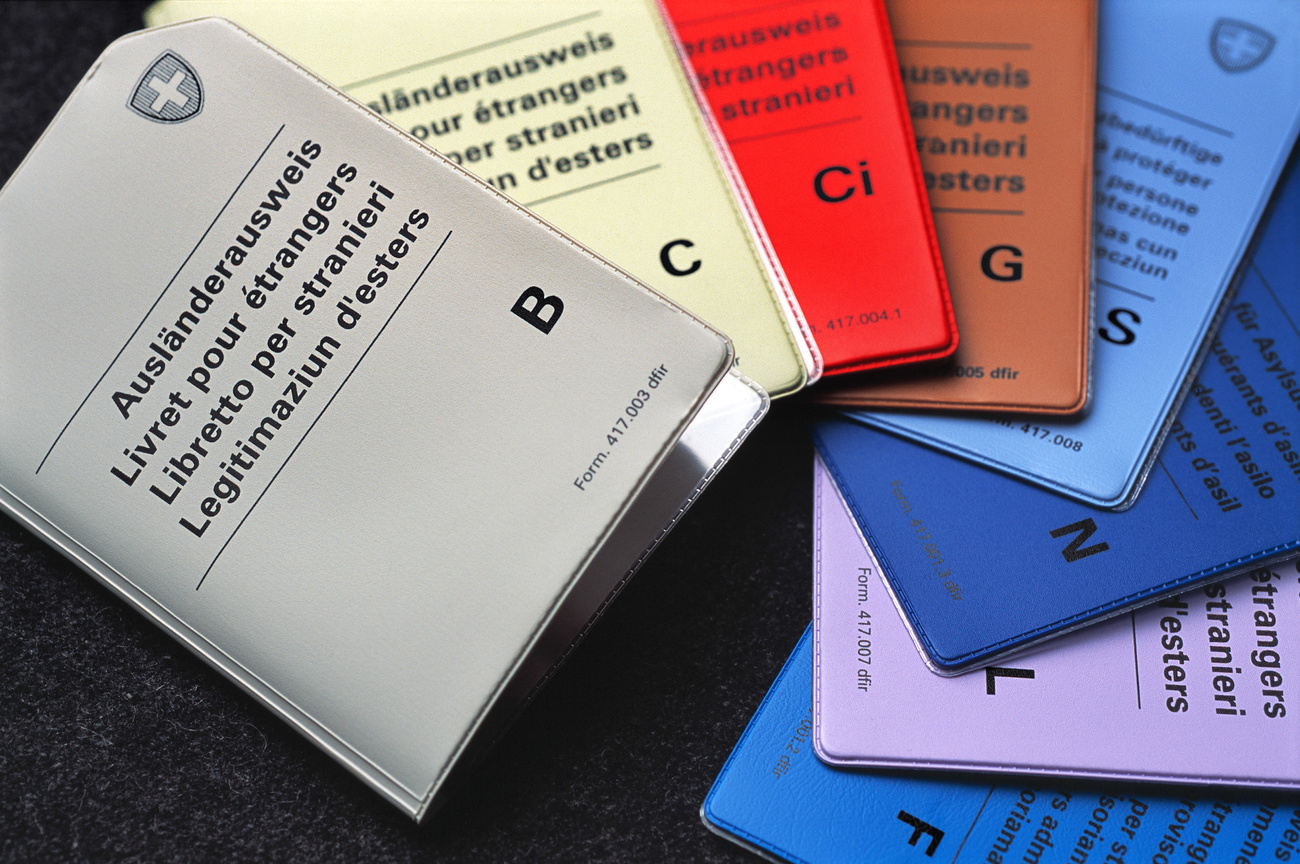Ukrainians in Switzerland: what’s next after two years of protection?

Two years ago, the Swiss government activated protection status S for Ukrainian refugees – a first in the Alpine country. Integration into the labour market, however, remains a problem.
“There was simply no alternative to implementing status SExternal link,” says Claudio Martelli, deputy director of the State Secretariat for Migration (SEM), looking back on the last two years in Switzerland.
So-called status S is intended for large refugee movements resulting from acute war situations. It’s meant to prevent the asylum system from becoming overburdened, as those who apply for this status do not go through an asylum process. Instead, they are temporarily admitted, are allowed to work, and are entitled to social assistance.
“What the cantons, municipalities and cities have achieved in the first phase is very impressive,” says Martelli.
Only one in five are working
Today, around 66,000 Ukrainians are holders of a status S permit. But the government sees the need to take action: only 20% of working-age Ukrainian refugees currently have a job.
This is despite the fact that several sectors are desperately looking for labour amid a shortage of skilled workers. Ukrainian refugees often have a high level of education. In November 2023, the Federal Council announced that it wants to double the rate of employment among Ukrainian refugees to 40%.
Swiss entrepreneurs are desperately looking for skilled labour:

More
Swiss firms struggle with acute staff shortages
A conference held in Bern in March, organised by the National Centre of Competence in Research External link(NCCR) and the UN Refugee AgencyExternal link, addressed the problems with labour market integration.
Yelyzaveta Glynko and Peter Mozolevskyi, both refugees from Ukraine, see a number of reasons for the low employment rate. One difficulty is the lack of recognition of diplomas and specialist titles. A person who worked as a psychiatrist in Ukraine, for example, cannot simply take up a position as a psychiatrist in Switzerland. Language is also often an obstacle.
“Nobody thought the war would last so long,” says Andrej Lushnycky, the Ukrainian honorary consul in Switzerland. At the beginning, therefore, taking a language course, further training or professional reorientation didn’t seem necessary.
Employers and Ukrainians have trouble finding each other
“But if you are ready to do something different, there are plenty of jobs available,” says Daniella Lützelschwab of the Swiss Employers’ Association. The challenge for employers is that “we don’t know where these people are and how we can find them,” she adds.
Small and medium-sized enterprises (SMEs) in particular lack the resources needed to find Ukrainians. “This would have to be organised by each individual sector,” says Lützelschwab. Mozolevskyi identifies the same problem with the Ukrainians themselves. “Many have no idea what possibilities and jobs are available in Switzerland,” he says. “There is a lack of communication.”
The federal government is aware of this problem, says Philipp Berger, head of the SEM’s Labour Market Admission Division. “We are working on proposing measures.” These include “matching”, or bringing employers and employees together, and more effective communication – “this is one of the lessons learned”, he says. Other channels, such as social media or reports in Ukrainian media, need to be considered.
Parliament wants to ease administrative burden for employers
Parliament too wants to improve the integration of status S holders into the labour market. In March, the House of Representatives and the Senate adopted a motionExternal link to this effect proposed by the political institutions committee.
It seeks to replace the work permit requirement with a registration requirement. This would provide more flexibility and be less of a deterrent to potential employers because only one online form would need to be completed.
Lützelschwab of the Swiss Employers’ Association welcomes any ease in administrative requirements but she is also sceptical of any effect this proposal might have. “Above all, we are calling for predictability,” she says. It’s very difficult to employ people when it’s unclear how long they will be staying in Switzerland, or how long their status S protection will last. She would therefore like to see communication at an early stage from the federal government.
Short-term training
In canton Vaud in French-speaking Switzerland, only 10% of refugees from Ukraine are employed. This is lower than the average for German-speaking Switzerland. The Vaud government has therefore developed its own solution, says Isabelle Moret, who heads the canton’s Department of Economy, Innovation, Employment and Heritage.
Unlike other refugees, people from Ukraine do not want to spend the rest of their lives in Switzerland. The focus is therefore on short-term training programmes of a few weeks that lead directly to a job. For example, a pilot project is currently underway with GastroVaud to recruit workers for the gastronomy industry. “This is particularly worthwhile in sectors that already have a high turnover rate,” says Moret.
Luchnycky, the Ukrainian honorary consul, welcomes this idea. Quick solutions are necessary because it is important to remember that these people will one day return to Ukraine. “An empty Ukraine would be a big problem,” he says. “It is essential that people return so the country can be rebuilt.”
Ideally, this would also open up new opportunities: Swiss companies that support reconstruction in Ukraine could deploy Ukrainian employees already familiar with the company to work there in the future. And these will be needed. “Around 6 million people are currently living as refugees in European countries, and are therefore absent from Ukraine,” says Luchnycky.
Switzerland doesn’t know what people are doing
Moret is disappointed that the Federal Council defined a 40% gainful employment aim. “Actually, 100% of the refugees should be occupied, but not necessarily as workers,” she says.
Children should be in school, 18 to 25-year-olds should be undertaking higher education, and those who are suffering from physical or psychological trauma should be receiving care instead of working. Language courses are also important. Furthermore, there are mothers who must stay at home to take care of their children because childcare is difficult to find in Switzerland.
“In canton Vaud there are 3,600 Ukrainians between the ages of 18 and 65 years,” says Moret. “We don’t know what 2,000 of those people are doing.” They are not registered with the regional employment centres and have not applied for a work permit. “Maybe they are working remotely for a Ukrainian company or maybe they are doing a course without following an official path,” she adds.
To gain clarity, these 2,000 people have been asked to report to the canton. “Before we can support these people, we first have to know what their situation is,” says Moret. Those who don’t report will have to pay a fine, she explains, not because they will be forced to work, but in order to better understand their situation.
Evaluating various asylum statuses
According to Moret, the experience with status S could be interesting for other refugee groups. The UNHCR agrees: although the rapid assistance programme is welcome, says the UN agency, status S also creates differences between refugees.
Anja Klug, head of the Swiss office of the UNHCR, says that while status S is not desirable for all refugees, it is important to talk about the rights of all refugees, especially those who have been temporarily admitted and have fewer rights than recognised refugees.
An evaluation group set up by the Federal Department of Justice and Police is currently investigating what lessons can be learnt from the application of status S. “This group will present a report in the middle of the year in which the various statuses in the asylum system will be compared and contextualised,” says Martelli of the SEM.
He adds that it would be illusory to use the experience of status S to try and solve all the contradictions and missteps in Swiss asylum legislation. “But there have already been several adjustments in the past,” he says. “We have taken a step forward.”
For more stories like this, sign up to receive our briefing.
Edited by Marc Leutenegger; adapted from German by Sue Brönnimann/gw

In compliance with the JTI standards
More: SWI swissinfo.ch certified by the Journalism Trust Initiative









You can find an overview of ongoing debates with our journalists here . Please join us!
If you want to start a conversation about a topic raised in this article or want to report factual errors, email us at english@swissinfo.ch.